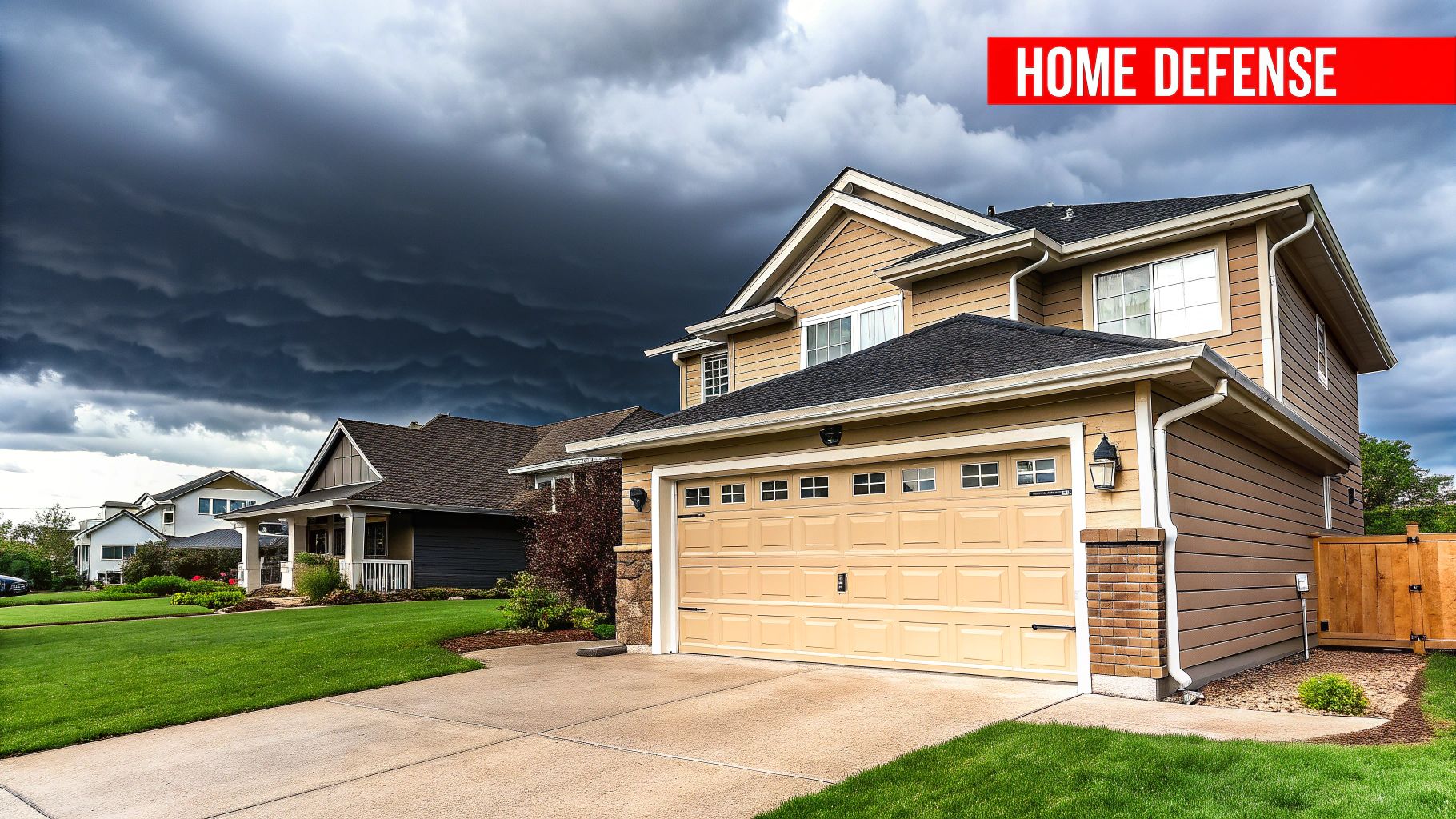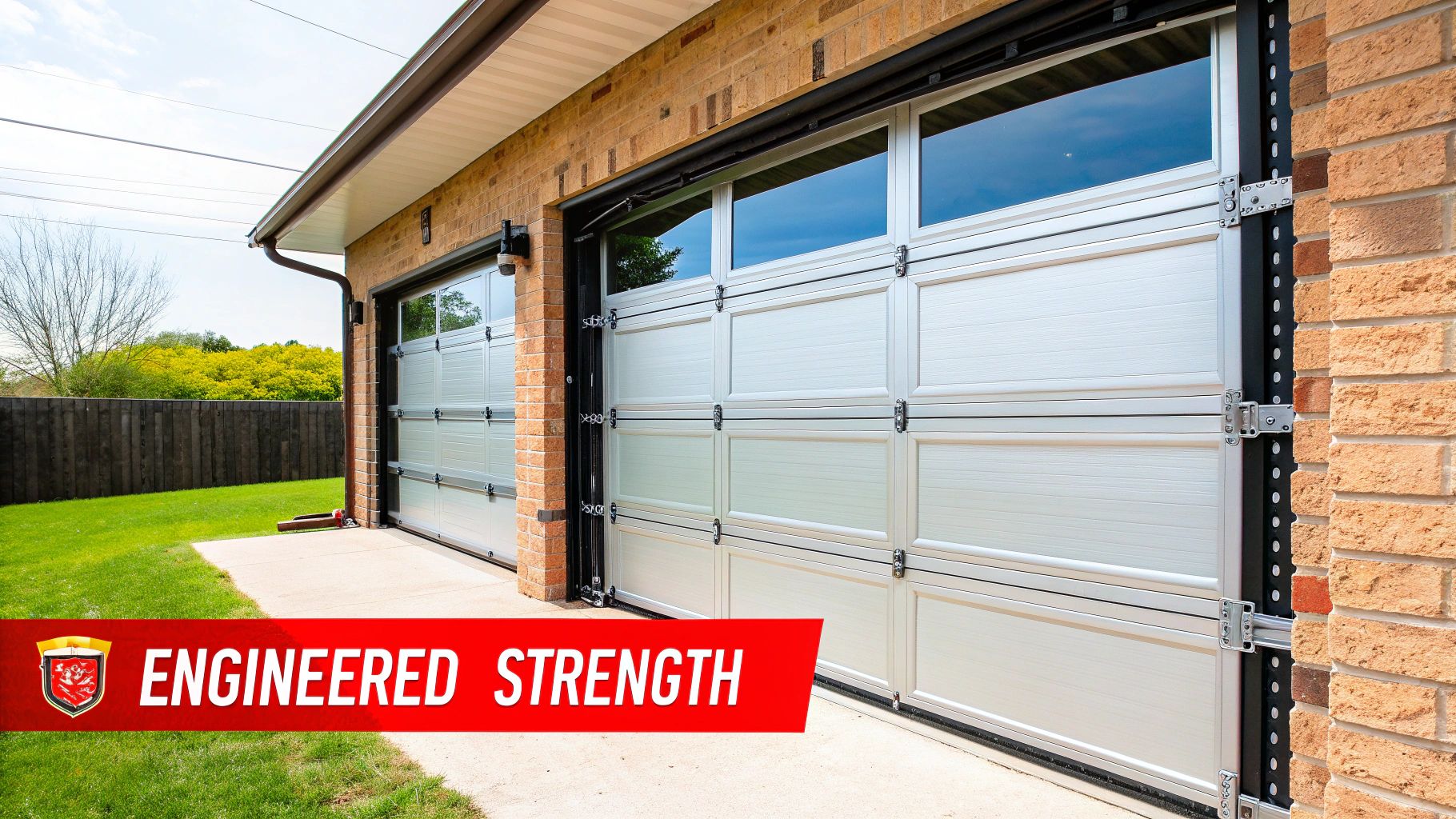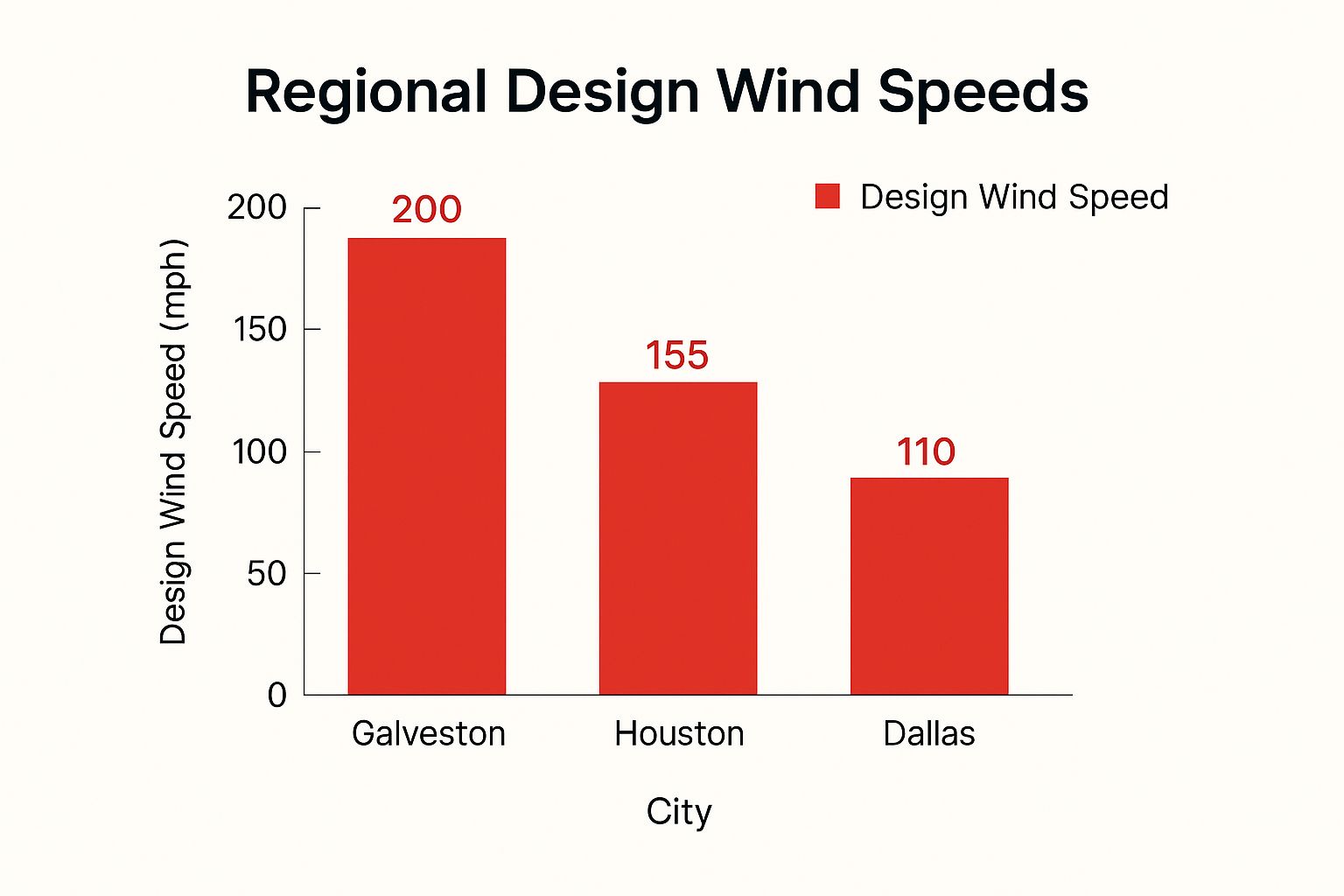A hurricane-rated garage door isn't just a door; it's an engineered defense system. It’s designed from the ground up to withstand the extreme wind pressure and impact from flying debris that storms in Texas and Oklahoma can unleash. Unlike a standard door, these systems use heavy-gauge steel panels, reinforced tracks, and specialized bracing to hold the line when it matters most. For property owners in storm-prone regions, it's a critical infrastructure investment.
Why Your Garage Door is Your Building’s Weakest Link
During a hurricane or severe windstorm, the largest opening on your property is also its most vulnerable point: the garage door. Statistically, it is one of the first structural elements to fail under the assault of extreme wind. Once that breach occurs, a catastrophic chain reaction can begin.

When a standard garage door fails, a massive volume of air rushes into the structure. This sudden influx creates immense positive internal pressure, pushing upward on the roof and outward on the walls. The effect is similar to overinflating a balloon—the structural envelope can no longer contain the force, often leading to roof uplift and subsequent structural collapse.
The Critical Role of a Hurricane-Rated System
This is precisely the scenario hurricane-rated garage doors are engineered to prevent. They aren't just stronger doors; they're integrated systems designed to maintain the structural integrity of your building's envelope.
Here’s a breakdown of their function:
- Prevents Wind Intrusion: A combination of heavy-gauge steel, strategic bracing, and impact-resistant materials creates a formidable barrier against both sustained high winds and violent gusts.
- Maintains Structural Pressure: By keeping wind out, the door prevents the dangerous internal pressurization that can blow a building apart from the inside out.
- Protects Assets: Whether it's a family's vehicles or a commercial business's entire inventory, these doors safeguard the valuable assets stored inside.
According to the Federal Emergency Management Agency (FEMA), garage door failure is a primary cause of catastrophic damage in hurricanes. A breach at the garage door increases the likelihood of roof and wall failure by a significant margin.
For a broader view of storm readiness, a comprehensive hurricane season preparation checklist can help you secure every aspect of your property.
The Engineering Behind Storm-Ready Garage Doors
What truly differentiates a standard garage door from one engineered to withstand a hurricane? The distinction lies in a fully integrated system where every component is designed and tested to work in concert against incredible forces.

When a weak garage door fails, wind rushes in, creating a massive buildup of internal pressure that can tear a building apart. A hurricane-rated door is the shield that prevents this initial breach, preserving your property's structural integrity.
The Anatomy of a Hurricane Rated Door
A certified storm-ready door is far more than just thicker panels. It’s a network of components where the official rating applies to the entire assembly—from the panels down to the rollers. Any system is only as strong as its weakest link. These doors are built to handle the dual threats of extreme wind pressure and impacts from flying debris, utilizing high-strength materials like reinforced steel and heavy-duty hardware.
Let's break down the key components:
- Heavy-Gauge Steel Panels: These doors feature robust steel panels, often 24-gauge or thicker, specifically designed to resist buckling, bending, and punctures under extreme pressure.
- Reinforced Bracing Systems: The interior of the door is fortified with horizontal steel trusses (U-bars or C-channels) mounted on each panel. This "steel skeleton" distributes wind forces evenly across the entire structure, preventing it from caving in.
- Heavy-Duty Tracks and Rollers: The tracks are made from thicker steel and are anchored more securely to the wall structure. The rollers, often made of durable nylon with long stems, are designed to remain seated in the tracks even under violent shaking and pressure.
It's a common misconception that only the door panels need to be strong. In reality, testing by the Insurance Institute for Business & Home Safety (IBHS) shows that track and roller failure is a frequent cause of catastrophic door collapse during a storm.
Impact Resistance and Glazing
Beyond wind pressure, flying debris poses a significant threat. A 2×4 piece of lumber traveling at hurricane-force speeds can easily penetrate a standard garage door. To counter this, hurricane-rated doors can include impact-resistant features. If the door has windows, the glazing becomes a critical line of defense. This isn't standard glass; it's specialized hurricane impact glass designed to crack but not shatter, preventing dangerous projectiles from entering.
Each of these engineered components must work together flawlessly. Ensuring all your garage door accessories are also rated for high performance completes the protective shield for your property.
Decoding Wind Ratings and Texas & Oklahoma Building Codes
Understanding the labels and codes on a hurricane rated garage door is essential for making an informed decision. These ratings are not technical jargon; they are a data-backed guarantee of a door's performance under extreme force.
The most common system is the WindCode rating, ranging from W1 to W9. The higher the number, the greater the wind pressure the door is certified to withstand. These ratings are derived from rigorous testing protocols, such as the ASTM E330 standard, where door assemblies are subjected to intense positive and negative pressure cycles to simulate hurricane conditions. Selecting the right WindCode is a matter of safety, legal compliance, and insurance validity.
Translating WindCode Ratings to Real-World Strength
This table helps illustrate the protective capacity of each rating level:
WindCode Rating to Wind Speed Correlation
| WindCode Rating | Approximate Sustained Wind Speed (MPH) | Typical Use Case / Geographic Area |
|---|---|---|
| W1 | 90 MPH | Inland areas with lower wind speed requirements, like North Texas or Oklahoma. |
| W4 | 110 MPH | Regions further from the coast but still susceptible to strong storm systems. |
| W6 | 130 MPH | Areas closer to the coast that experience significant wind from tropical storms. |
| W8 | 150 MPH | High-risk coastal zones requiring robust protection against major hurricanes. |
| W9 | 150+ MPH | The most vulnerable coastal regions where direct hurricane impact is a major threat. |
As proximity to the Gulf Coast increases, the required rating rises dramatically in direct correlation with the heightened risk, a fact strictly enforced by local building codes.
Why Your Location Dictates Your Garage Door Requirements
Building codes across Texas and Oklahoma are not uniform. They are highly specific, tailored to the meteorological risks of each county and municipality. A door that is code-compliant in Denison could fail inspection and create a serious hazard in Galveston. Proximity to the coast is the primary factor driving these requirements.
This infographic illustrates how wind speed requirements vary across different Texas cities.

The data is clear: a property in Galveston must be prepared for wind forces nearly double those expected in Dallas, demanding a higher standard for all structural components, especially the garage door.
Actionable Tip: Property owners are responsible for selecting a door that meets or exceeds their local building code. Installing an underrated door can void warranties, lead to denied insurance claims, and result in catastrophic structural failure.
Navigating local regulations can be complex. Our team provides expert garage door installation, ensuring your chosen product is fully compliant with the specific codes in your area, whether for a home or a large commercial facility. In the long run, access to reliable garage door repair is crucial for maintaining that certified protection.
The Financial Case for a Hurricane Rated Door
Beyond the primary goal of storm protection, installing a hurricane-rated garage door is one of the most financially prudent decisions a property owner in Texas or Oklahoma can make.
While safety is paramount, the financial benefits—from immediate cost savings to long-term value appreciation—provide a compelling case for this upgrade.
Lowering Your Insurance Premiums
One of the most immediate returns on investment is a reduction in your insurance premiums. To an insurer, a standard garage door in a high-wind zone represents a significant liability. By upgrading to a certified, code-compliant hurricane door, you demonstrably reduce this risk.
Actionable Tip: Insurers often provide substantial discounts for wind mitigation efforts. It is not uncommon for property owners to save 15-25% annually on their premiums. A hurricane-rated door is one of the single most effective upgrades for qualifying for these savings. After installation, immediately provide the product approval documents and wind rating certificate to your insurance agent.
Over several years, these premium savings can significantly offset the initial cost of the door.
Boosting Property Value and Marketability
In markets like Texas and Oklahoma, "storm-ready" is a powerful selling feature. A home or commercial building equipped with a hurricane-rated garage door is instantly more attractive to buyers who understand the local climate risks. This is a fundamental structural upgrade that adds measurable value, justifying a higher selling price and potentially reducing time on the market.
Enhanced Security Against Intruders
The features that make these doors hurricane-resistant also make them exceptionally difficult for intruders to bypass.
- Pry-Resistant: The heavy-gauge steel and reinforced construction make prying panels open nearly impossible.
- Impact-Resistant: Materials designed to withstand flying debris are a major deterrent to forced entry.
- Secure Tracks: Heavy-duty tracks and long-stem rollers prevent the door from being forced off its rails.
This built-in security protects your family, inventory, and valuable assets. The market for these doors reflects this growing awareness; it's projected to hit USD 1.8 billion by 2033, with a compound annual growth rate of 5.2%. You can learn more about these market trends to understand how this is becoming a standard for resilient construction.
Budgeting for Your Hurricane Door Installation
A common question is, "What is the cost of a hurricane-rated garage door?" While the upfront cost is higher than a standard door, it should be viewed as a critical investment in your property's long-term resilience and value.
The final price is determined by several key factors. Understanding these helps you build a practical budget that aligns with your property's specific needs in Texas and Oklahoma.
Key Factors That Influence Your Total Cost
The cost of a hurricane-rated door can vary significantly based on customization and performance requirements.
Here’s a breakdown of the main price drivers:
- Door Size: A double-car garage door requires more material and reinforcement than a single door, directly impacting the cost.
- Material Composition: Options include steel, aluminum, and composites. Heavy-gauge, impact-resistant steel is a popular choice for its strength-to-cost ratio, while custom composite models may be priced higher.
- WindCode Rating: A higher WindCode rating—such as a W8 or W9—requires more robust bracing, thicker steel, and stronger hardware. This advanced engineering adds to the cost. The key is to match the rating to your local code without over-engineering.
- Insulation (R-Value): An insulated door adds structural rigidity, enhances energy efficiency, and provides sound dampening. Doors with a higher R-value (e.g., R-12 or higher) typically cost more but can yield returns in energy savings.
Based on market data, a single hurricane-rated door can range from $800 to $6,200, while a double door may cost between $2,000 to $10,000. The growing demand in storm-prone regions reflects a clear trend toward prioritizing property protection. Discover more insights on the garage door market.
The Non-Negotiable Cost of Professional Installation
While it may be tempting to cut costs, professional installation is non-negotiable. This is a technical process that ensures a life-safety system functions as designed and certified.
Attempting a DIY installation or hiring an uncertified handyman is a significant risk. An improperly installed hurricane door will not perform to its rated standard, will void the manufacturer's warranty, and will fail a building code inspection.
Here’s why budgeting for a professional is essential:
- Code Compliance: Certified technicians are experts in local Texas and Oklahoma building codes, ensuring your installation is 100% compliant.
- Warranty Validation: Manufacturers' warranties are contingent on installation by an authorized professional.
- Guaranteed Performance: A door's WindCode rating is only valid if the entire system—panels, tracks, springs, and fasteners—is assembled to precise manufacturer specifications.
Investing in expert garage door installation is the final, critical step to ensure the system you purchased will defend your property when a storm hits.
Protecting Your Investment with Proper Maintenance
Installing a hurricane rated garage door is a major investment. Like any high-performance equipment, it requires routine maintenance to ensure it remains ready to perform under pressure. Neglecting upkeep can allow wear and tear to compromise the door's structural integrity, turning a small issue like a corroded hinge into a catastrophic failure point during a storm.
Your Essential Maintenance Checklist
Homeowners and business owners can perform basic checks to spot potential issues early. It's a good practice to run through this list every few months, and especially before the start of hurricane season.
- Visual Inspection: Examine the door inside and out. Look for rust or corrosion on panels, hinges, and tracks, which is common in the humid climates of Texas and Oklahoma.
- Clear the Tracks: Ensure tracks are free of dirt, leaves, and debris that can obstruct rollers and place stress on the system.
- Test the Balance: Disconnect the automatic opener and manually lift the door halfway. A properly balanced door should remain in place. If it rises or falls, the springs require professional adjustment.
A study on garage door failures found that improper maintenance is a leading cause of premature component failure. Even something as simple as a dry, squeaky roller can eventually damage the track and compromise the door's ability to resist wind.
The Critical Role of Annual Professional Servicing
While DIY checks are useful, they are not a substitute for an annual inspection by a certified technician. A professional has the expertise and tools to safely service high-tension components that are critical to performance and safety.
An annual service visit ensures your door maintains its certified rating. Here’s what a technician will typically cover:
- Inspect Springs and Cables: Check for signs of fraying, corrosion, or fatigue that could indicate impending failure.
- Examine Reinforcement Trusses: Verify that all horizontal bracing is securely fastened and structurally sound.
- Lubricate Moving Parts: Apply lubricant to rollers, hinges, and bearings to ensure smooth, quiet operation and reduce wear.
- Tighten All Hardware: The constant vibration of door operation can loosen fasteners over time. A technician will tighten all hardware to manufacturer specifications.
Actionable Tip: If you notice grinding noises, jerky movement, or visible damage, schedule a professional garage door repair immediately. Addressing small problems promptly can prevent them from becoming major liabilities.
Your Top Questions About Hurricane Garage Doors, Answered
Upgrading to a hurricane-rated door is a significant decision, and it's normal to have questions. Here are clear, data-driven answers to the most common inquiries from property owners in Texas and Oklahoma.
Can I Just Reinforce My Existing Garage Door?
This is a frequent question, as it seems like a cost-effective solution. However, aftermarket bracing kits installed on a standard, non-rated door rarely provide certified protection. These modifications do not meet the stringent testing standards required by building codes in high-risk areas of Texas and Oklahoma. Furthermore, altering a standard door will void its original manufacturer's warranty. The only way to guarantee code compliance and certified performance is by installing a complete, engineered hurricane-rated system where all components have been tested together.
Is a Higher WindCode Rating Always Better?
Not necessarily. The goal is to select the appropriate rating for your specific location. A door with a W9 rating designed for the Galveston coast would be over-engineered—and unnecessarily expensive—for a commercial building in Shawnee, Oklahoma. The most cost-effective and sensible approach is to choose a rating that meets or slightly exceeds your local building code requirements. A professional can help you identify the precise rating needed to ensure compliance and safety without overspending.
Are Hurricane Rated Doors Louder or Harder to Use?
Contrary to what you might expect from a heavier, more robust door, modern hurricane-rated systems are engineered for exceptionally smooth and quiet operation. They are built with higher quality components, including precision-calibrated springs and powerful openers designed to handle the additional weight effortlessly. The solid construction and added insulation also provide superior sound dampening, reducing vibrations and exterior noise. A professionally installed system is just as easy to operate as a standard door, and often much quieter.
Ready to secure your property with a door engineered to withstand the toughest storms? The team at Overhead Door Co. of Tex-Oma provides expert guidance and professional installation to ensure your home or business meets local codes and is protected when it matters most. Get in touch with us at our website.
